If any two species present a particular problem for the taxonomist in terms of their perceived variation, it must be these two. I wrote a short article discussing this in respect of one particular population of Haworthia arachnoidea (Aloe 38:76, 2001). I also wrote on the same problem in my book Haworthia Update Vol.1 (Umdaus Press, 2002). Despite some of the things I said there, there is still some misunderstanding expressed in informal communication regarding my approach, not only to the recognition of varieties, but to the interplay between what have been perceived to be different species. One of the complaints is that if I do not recognise some of the new varieties described by other authors, my own varietal taxa should not be taken seriously. In my Aloe article I wrote… “I have used varieties simply as a communication and descriptive tool to suggest lesser nodes and connections between what I think may be species.” In my revision (Haworthia Revisited, 1999, Umdaus Press), I wrote…”Lesser ranks should not be taken too seriously.”
In about 1972 I was exploring west of Ladismith (Winkelplaas, MBB2716) when I for the first time came upon a problematic population which was neither H. arachnoidea nor H. mucronata. Subsequently the problem this presents for classification has grown with virtually every outing I have made into the Little Karoo. I now have a vast amount of material which is, however, still inadequate in terms of geographic coverage to form the basis of a fully comprehensive report. This short note simply arises out of a curious report kindly sent to me by Ingo Breuer who stated that H. arachnoidea grew together with H. mucronata at Grootrivier, west of Ladismith. I was very dubious about this statement because his locality is at Buffelsdrif which is virtually at east of Winkelplaas.
To explain that I first would like to briefly explain and illustrate my interpretation of what H. mucronata is. The name (note just the name) that designates the species is typified by an illustration in the Kew herbarium (Fig. 2) to which no exact origin is attached. In my earlier works I regarded the name as insufficiently typified and chose rather to use von Poellnitz’ name H. unicolor based on plants from south of Barrydale (see Figs.3a & b MBB7216). Scott preferred to uphold these Barrydale plants as the species H. mclarenii and use the name H. mucronata for a Dekenah collection from Calitzdorp. To accommodate Col. Scott I unwisely used his application of the name mucronata to the system of populations that I considered to be the same one species for which I applied the name unicolor. I should have stayed with the name H. unicolor based on a geographically designated collection and left the name H. mucronata as of doubtful origin and hence uncertain (see Endnote). This is now water under the bridge. I use the name H. mucronata for a system of populations which extends from west of Montagu to east of Oudtshoorn (see also endnote). I should designate an epitype which would be … Cape(3320DC): Barrydale, J. Dekenah 234 (NBG) = MBB7216, to make it quite clear from which field population it is derived and to which I attach the name. But this is also not so simply resolved. My plants in Figs.3a & b (MBB7216) are of large glabrous plants on a warm and dry north slope at Barrydale. There are smaller plants on the cool, wetter south slope only about 100 meters away (Fig.4 MBB7213). Fig.5 (MBB7212) shows two larger, spined plants from Tradouwshoek, a locality about 1.5km north-east of Barrydale on a moderate south slope. In the Tradouw pass a few kilometers away there are plants which could just as well be H. arachnoidea or extensions of these variable plants of H. mucronata from Barrydale itself.

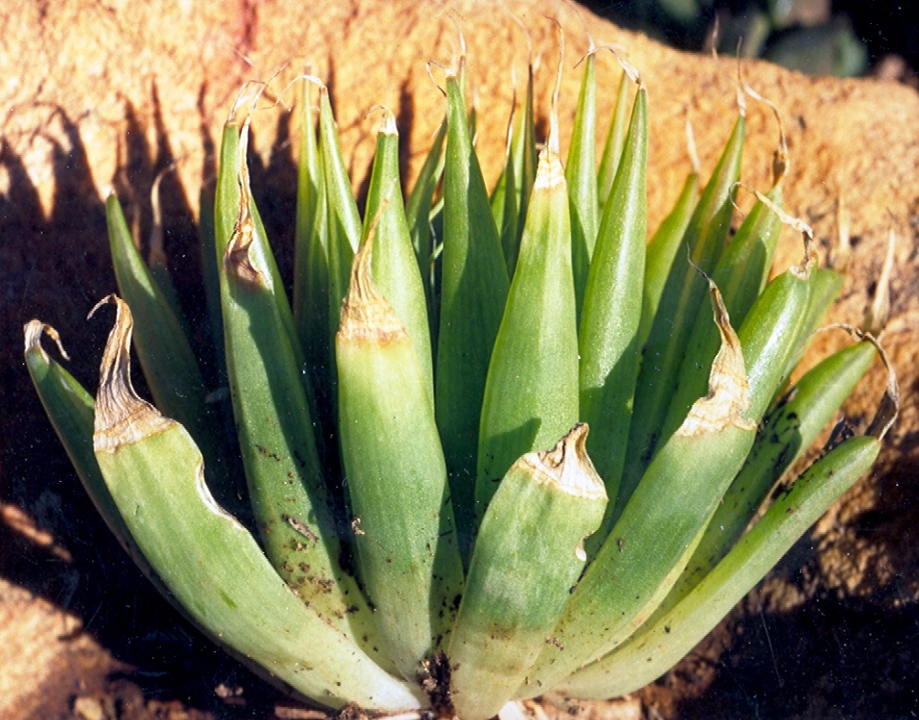
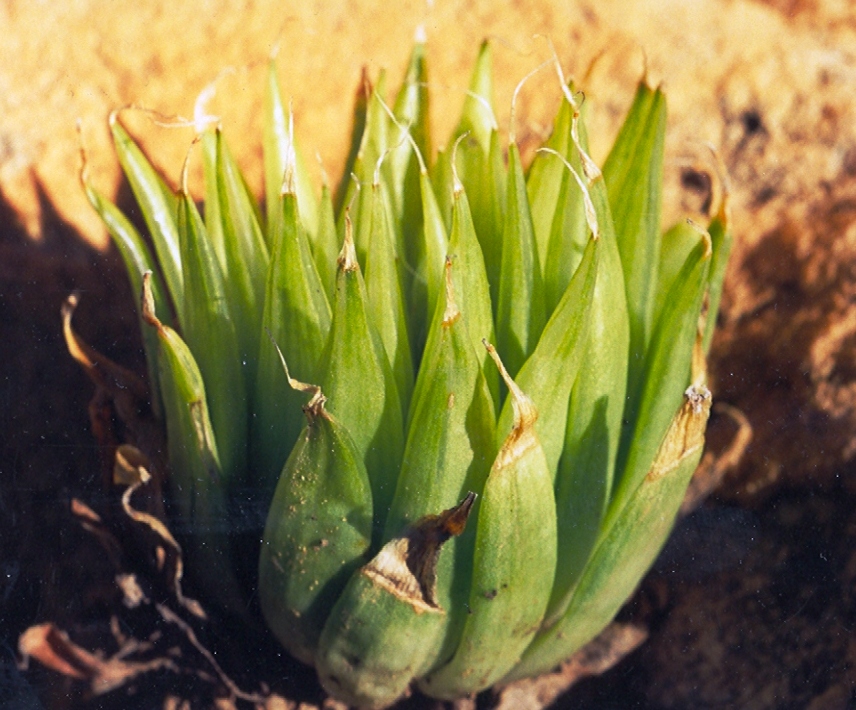
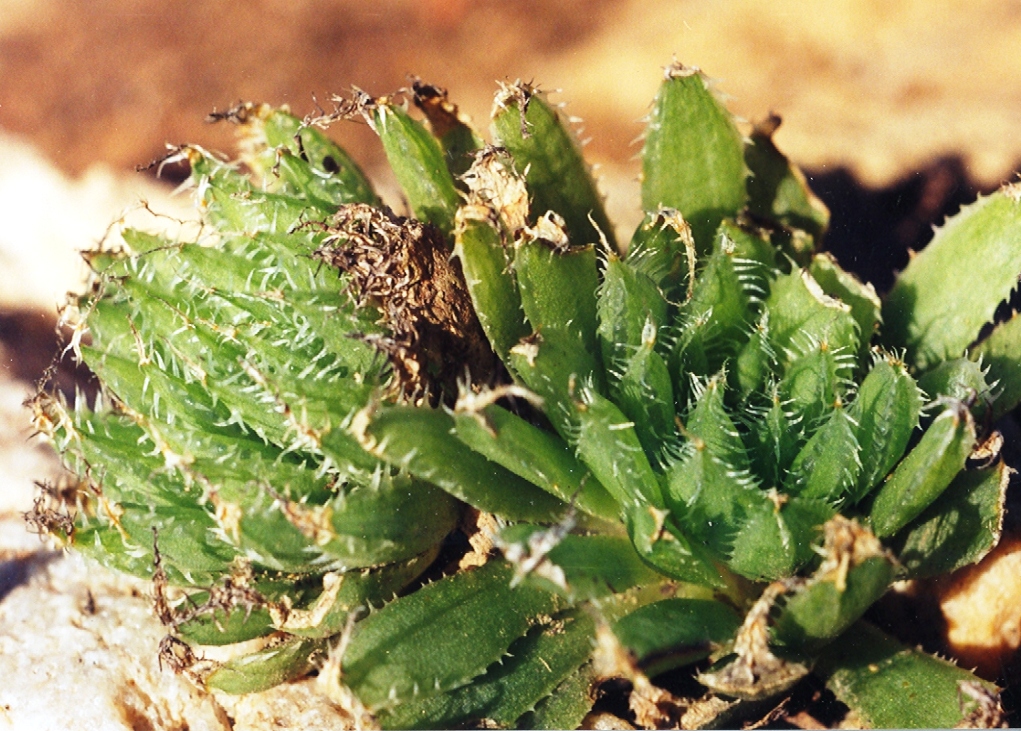
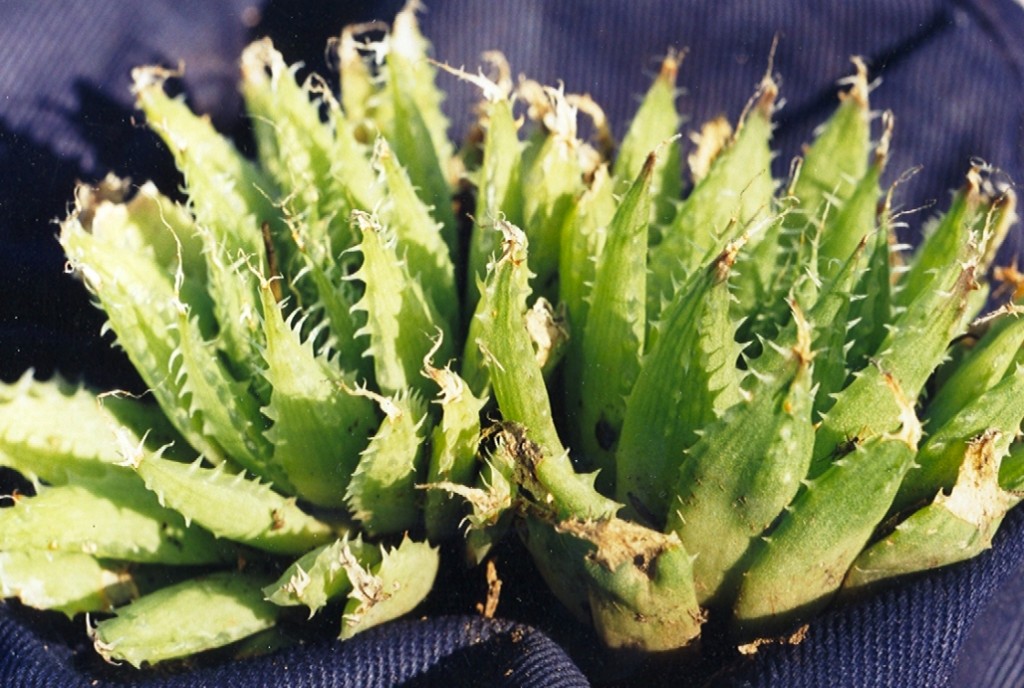
Having said this, I must point out that this article does not seek to explain or illustrate the full extent of the variability of either species. H. arachnoidea is illustrated in Fig.6 (MBB7207). This is of a plant from the site at Buffelsdrif [2] presumed to be that indicated to me by I. Breuer. Had I seen this plant alone I would have said “Yes, this is clearly H. arachnoidea.” I would have been embarrassed to have to add “var. setata” which I use to denote the Little Karoo variants of this species, because there is really no good basis for such a varietal distinction and I never fully believed that there was. The problem is, that as Breuer suggested, there is something else present. This is a smaller fairly glabrous plant with some marginal translucence to the leaves (Fig.7, also MBB7207). Does this then mean that H. arachnoidea and H. mucronata are there growing sympatrically (co-occurring, growing together in one habitat)? Unfortunately the spot we explored was rather confined and time did not permit further exploration. I am not certain this is in fact the exact site referred to by Breuer, but there were no other options in terms of his referral. What does therefore motivate me to write is the information peripheral to the report and what we saw elsewhere on this particular excursion. My old Winkelplaas collection tells me that we have “hybridisation” of the two species. But other collections suggest to me that this “hybridisation” is so extensive throughout the Little Karoo that it cannot be dismissed so simply.
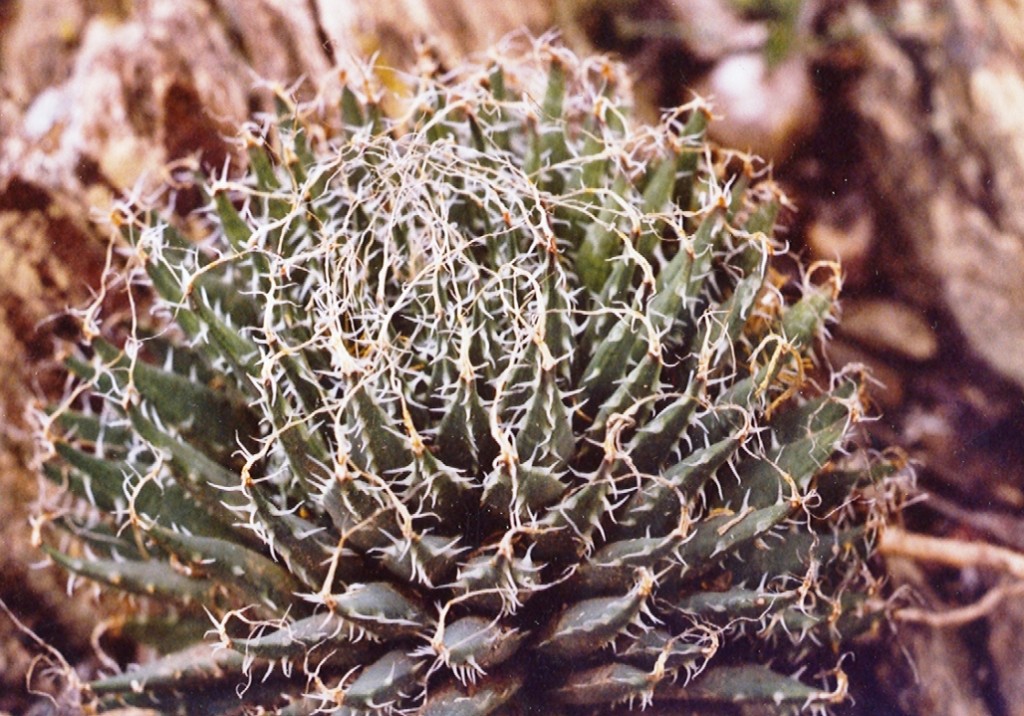
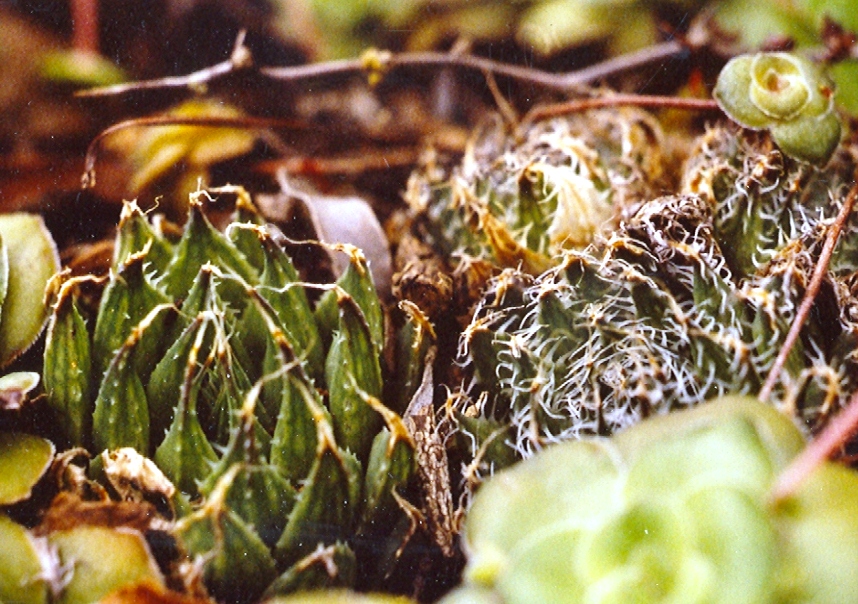
In Haworthia Update Vol.1, I indicated how intensively one has to explore to properly account for field variability. The Buffelsdrif/Winkelplaas area has many potential habitats that would have to be searched to fully explain what is there. Just on this one outing we stopped at several places. At Vensterkrans a short distance to the south-west, we explored four hillsides. Figs.8a & b(MBB7205) are of spinose and glabrous plants from west of Vensterkrans [3]. They are paler in colour than H. arachnoidea and they exhibit a degree of translucence. These are actually the two characters by which I would suggest the two species could be generally distinguished i.e. arachnoidea – very dark-green and with no translucence to the leaves, mucronata – paler green and with translucence especially to the leaf margins. The two illustrations by no means indicate the degree of variation at this one site. Fig.9(MBB7206) is of a plant from between Vensterkrans and the first noted Buffelsdrif locality [4]. It is mid-green, spination is reduced, there is no obvious translucence and the plant has very firm margins and keels to the leaves. This gives slightly greater rigidity in the rosette and is a common feature in plants from many populations in the greater area. Also the plant is but one from a highly varied assemblage – none of which resemble either H. mucronata or H. arachnoidea. It is for populations of this ilk that I adopted the varietal name H. arachnoidea var. nigricans, explaining that it was only a device to accommodate plants (largely as populations) that were neither H. arachnoidea nor H. mucronata, but something in-between. One could equally have applied the varietal epithet for these plants under H. mucronata. As proposed with H. cooperi/gracilis, this is once again a case where a series of intermediate populations (in this case called H. arachonidea var. nigricans) blur the distinction between the ‘core’ species (largely because of the vagaries of nomenclature and application of types), H. arachnoidea and H. mucronata, thus invalidating any neatly definable species boundaries.
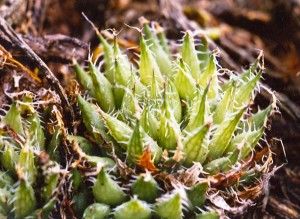
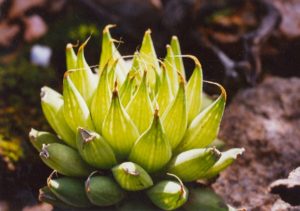
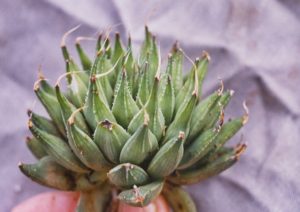
Figs.10a & b (MBB7210) are of two smaller plants from east of Vensterkrans [5]. Plants from map site [6] are comparable with sites [3], [4] and [5]. These are similar to the preceding plants illustrated as H. arachnoidea var. nigricans, but tend to be more compact, still less spinose, and on some plants there is no marginal translucence. When I first saw plants of this ilk from about 8 kilometres to the east, I speculated that maybe this is where H. marumiana had originated as judged from an old Luckhoff collection from Ladismith designated by Von Poellnitz as that species. The plants from east of Vensterkrans do in fact have some superficial resemblance to H. marumiana var. batesiana. Stressed young plants do suggest the typical variety of that species and I suggest that this accounts for Von Poellnitz’s erroneous reference (note the plant in Fig.7).
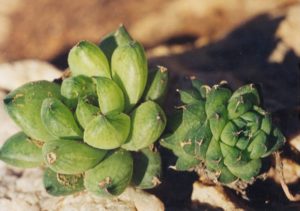

I conclude this note with Figs.11a & b (MBB7211) of plants from Springfontein some distance to the southeast and nearer to the Langeberg. The illustrations are of a spinose and a glabrous plant, neither of which have marginal translucence. I would identify them as H. arachnoidea var. nigricans, and say that this is what I used to denote by the name H. unicolor var. venteri in my 1982 work, The New Haworthia Handbook, Kirstenbosch. I then wrote … “It is not in the least clear what the relationship is between H. unicolor (now H. mucronata) and H. arachnoidea. I make this point again and again to explain that it is pointless trying to name and describe an endless array of taxonomic varieties in the mistaken belief that a better grasp has been obtained of this incredible interplay of natural systems. I think it is fairly useless to suggest that some unfortunate taxonomist in the future will be saddled with the task of deciding the validity of such efforts, when the evidence here in the present is already indeterminate.
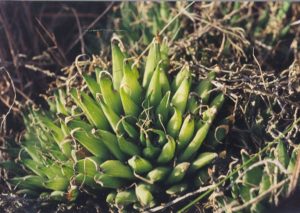
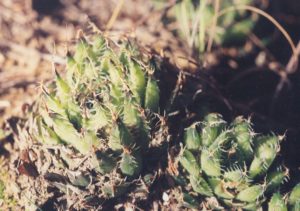
Endnote: It is perhaps useful to give Scott’s interpretation relating to the above:
1. He had H. mcclarenii in a section Loratae as a name specifically for Barrydale plants.
2. He he had H. mucronata in the section Denticulatae as a name for an array of specimens scattered across the landscape. Included in a wide array of “selected (herbarium) specimens are plants from:
Middelburg, Sterkstroom and Cradock, that are H. bolusii var. blackbeardiana),
Adelaide, Grahamstown, Uitenhage and Humansdorp, that are H. cooperi var. gracilis.
Napier, that is H. rossouwii.
Ladismith, Oudtshoorn, that are H. mucronata var. inconfluens.
3. He had H. aristata in a section Planifoliae on its own, also for plants from Barrydale and comingling with his distributions for H. mucronata.
4. He recognized two species viz. H. helmiae and H. integra from single localities in the Little Karoo, in a section Muticae.
All these five elements of Scott’s, in terms of names and origins, fall into the system/s to which I apply the names arachnoidea var. nigricans or mucronata. Nothing suggests to me that other writers have a better interpretation of very difficult problem in determining the degree of interfacing of this system with that of arachoidea, lockwoodii, decipiens and cooperi (the latter as discussed in Haworthia Update Vol.1).
Acknowledgement
I would like to record the credibility afforded to me by Western Cape Nature Conservation Board in extending permit approval for the limited collecting this kind of investigation requires. Mr. Johan Meyer of Barrydale was generous enough as to accommodate my wife and I, arrange landowner contact, add his own enthusiasm and interest, and accompany us on the excursion. I particularly would like to acknowledge the improvements and alterations to the manuscript suggested by Paul Forster of Queensland, Australia. It is clear that writing in the sphere of Haworthia now requires critical and informed comment before publication, and I appreciate this from Paul. ♦
